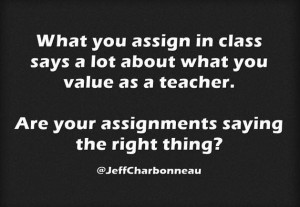No, I’m not talking about gas.
I spend a lot of time in classrooms at all grade levels. As I watch both the students and the teachers, it is an all too common fact that TEACHERS WORK WAY too hard! I know this is not a shock to anyone in the classroom right now. Let me explain further…
Teachers do way too much thinking for students. After lesson planning, grading, doing paperwork, attending meetings and contacting parents, we are also talking and thinking for students. Stop TOOTING teachers!
TOOT-which stands for Teacher Only One Talking is common in the classroom. Non-verbal expert, Michael Grinder, in his book Envoy, coined this acronym to encourage teachers to use nonverbal cues to manage the classroom (it works). I would extend this sage advice and caution to the direct instruction component of a lesson. Here is an summary of a lesson taught in two different ways:
The teacher plans to use an article and follow-up questions to work with students on using evidence from a text to support answers. He tells students to start byfirst looking at the questions . He then explains how to use a highlighter to underline evidence to support their answer to the questions. In addition, he reads the article out loud for students to follow along. After this, he may demonstrate and explain each step of the answering process and ask the students a few questions along the way. Many or few hands are raised to respond to questions and one or two may be called upon to provide the “right” answer. Hence…the teacher is TOOT-ing throughout the lesson.
or…
The teacher tells the students the target of the lesson is to practice using evidence from text to support answers to questions. He asks students to first think for 15 seconds and then share with a shoulder partner what might be the first step. A few students are called upon (all should be able to answer) and the opportunity to add anything not shared already is provided. The teacher adds to student responses by sharing thinking about why choosing to read the questions first would be a good strategy. As each of the steps are discussed based on student input, the teacher can hear the thinking behind students’ approach to the work. He can then guide them as needed. As long as the text is at an appropriate readability level, students can read silently or in partners after the teacher models reading (and thinking) for the beginning of the passage. Together, the class can create a model of the steps to answering the questions and using evidence to support answers. Through student talking, the teacher can get a good gauge of where students are needing the most support and how much guided practice is needed before allowing students to practice independently. Teachers and student talk is distributed and student responses can guide the next steps.
The book title, Never Work Harder Than Your Students by Robyn Jackson, captures what teachers should strive for. So much time is spent lesson planning, not to mention the many other decisions to make for learning. It is understandable that when it comes time to teach a lesson, the teacher takes the wheel and drives full speed ahead. It may also be thought that it is easier to manage the classroom when the teacher is talking and the students have to be quiet and listen.
What if teacher’s could still stay in control of the lesson, but shift more of the work to the students? What if instead of the teacher telling students exactly what to do, he or she tapped into having students do the thinking? Being a “guide, so no student can hide” instead of “sage on the stage” might lead to more energy for an after-school celebration! Students will enjoy the learning, not to mention learn more. Try talking less, and listening more. You might be surprised that you become a learner, too.
Mentors: Discuss with your mentee, “When do you notice your students least engaged?” Talk about increasing student “talk time” that is well structured and productive. How do you teach student talk time expectations, just like any procedure or routine? How can you plan questions during lesson planning that promote student thinking?
